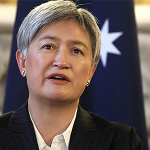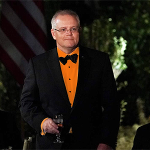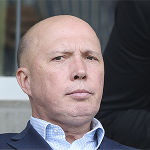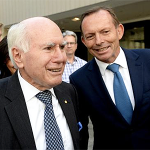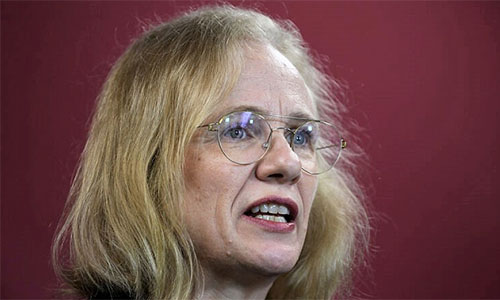President Zelensky is in the United States for his latest, possibly last, throw of the dice before the American election, in his attempt to prove that victory can be achieved against Ukraine’s Russian invaders.
The redoubtable leader of Ukraine has brought what he calls his ‘victory plan’, which embraces every facet of his nation’s future. It includes his strategy for forcing President Putin to end the war and for the West to guarantee his beleaguered country’s long-term security and economic prosperity.
It’s a grand vision which he will present to President Biden in the White House on Thursday. There are a number of conditions which are dependent on American support, whoever wins the election in November. It also envisages a time when Putin might be persuaded to accept that a ‘forever war’ is no longer in Russia’s interest.
Zelensky will see Biden on Thursday, and will also have sessions with Kamala Harris and Donald Trump
Victory has been a word Washington has tended to avoid. Biden has been Zelensky’s fervent supporter and defender ever since Russian troops crossed the border two years and seven months ago and has always promised to back Kyiv however long it takes. But did that mean all the way to victory? When he was chairman of the US Chiefs of Staff, General Mark Milley said the war would end by a politically-negotiated settlement, not by military prowess.
That is the reality. But the longer the war has continued, the more entrenched the political view, not just in Kyiv, has been that Putin needs to be deterred from any future aggressive ambitions and that Ukraine, therefore, had to win. Donald Trump was asked during the TV debate with Kamala Harris in Philadelphia whether he wanted Ukraine to win. He replied he just wished to end the fighting and stop people dying.
He was taken to task for this reply. But this probably reflects many private views even within the Biden administration. Indeed, for a long time officials in the National Security Council have been quite open about the need for the Kyiv government to recognise that a negotiated settlement was a realistic option for some point in the future. The issue was always that if negotiations were to take place between Kyiv and Moscow, Ukraine had to be in a position of strength on the battlefield in order to achieve maximum advantage.
This is where Zelensky’s new victory plan comes into its own. Although the fine details have not been made public, it seems clear that the Ukrainian leader will argue that now is the time – between October and December, he said – for big decisions to be made in Washington and by Nato as a whole. He is thinking, of course, of his desire for authority to use long-range western-supplied missile systems to hit multiple targets in Russia; and for Ukraine’s future to be embedded in Nato.
Zelensky is hoping that attacks on air bases and missile sites deep inside Russia, using the Franco-British Storm Shadow cruise missile and the US ATACMS rockets, plus the continuing presence of Ukrainian troops in a large slice of Kursk in western Russia, will finally persuade Putin to come to his senses.
In other words: negotiating from strength. That’s what Washington has been saying for months and that’s what Zelensky is now offering. It’s probably unfortunate that he chose to call his blueprint a ‘victory plan’ because victory implies the other side has been defeated. And Putin is not a leader who will ever concede defeat. Indeed, as the battleground stands at the moment, the Russian leader has seen his troops make progress in eastern Ukraine, he has brushed off the Kursk invasion and will be feeling quietly satisfied that his warning of war with Nato if Biden were to permit western long-range missiles to be used within Russia appears to have paid off.
This is why Zelensky’s visit to the US at this time is so important. He’ll see Biden on Thursday, and also have sessions with Kamala Harris, Donald Trump and congressional figures. Can he use his undoubted eloquence and persuasive powers finally to convince Biden and the future American president, whoever it is, to back what would be the biggest gamble of the war: to go for Putin with all guns blazing and force him to the negotiating table.
Biden has so far demurred. His vice president has shown no indication of adopting a different position if she wins the election, and Trump has made it clear he wants to impose his own plan on both Kyiv and Moscow to end the war as quickly as possible. Zelensky will make his pitch to the current and potential future presidents and will present his case for continued support when he addresses the UN General Assembly in New York tomorrow.
Will his victory plan make a difference in Washington? Only 11 days ago, Biden hesitated yet again when he met Sir Keir Starmer in the White House and discussed the question of authorising Zelensky to fire long-range US and British missiles at Russian targets. Starmer insisted the meeting was more about strategy than individual missiles. But Storm Shadow and ATACMS are inextricably linked in Zelensky’s mind with his strategy for winning the war.
If Zelensky’s victory plan is met with mixed feelings in Washington, he will return to Kyiv at the end of the week with the bitter realisation that he will have no alternative but to fight on in the hope of gaining some advantage on the battlefield before the winter sets in. And then wait to see who wins the US election and start another round of presentations, armed with his blueprint for victory.



